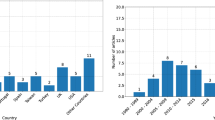Abstract
Failure mode and effect analysis (FMEA) model is a technique used to evaluate the risk. This paper aimed to propose a new FMEA model combining technique for order of preference by similarity to ideal solution (TOPSIS) and belief structure to overcome the shortcomings of the traditional index of FMEA. In this paper, the fuzzy belief TOPSIS method is combined with FMEA to introduce a belief structure FMEA to describe the expert knowledge by a number of linguists as a grammatical phenomenon. Moreover, the weights of components in FMEA index can be different from each other. Therefore, the flexibility of assigning weight to each factor in this method is more compatible to the real decision-making situation. In other word, TOPSIS method is applied to determine the preference of alternatives versus risk criteria. Using linguistic terms in the fuzzy belief approach, the risk factors described a more meaningful value and decision-makers’ judgment is assigned with belief degrees through evaluation of factors. Finally, a numerical case study about the preference of cause failures of steel production process is provided to illustrate the process of proposed method, and then result and discussion is performed for each case.
Similar content being viewed by others
References
Carbone TA, Tippett DD (2004) Project risk management using the project risk FMEA. Eng Manag J 16(4):28–35
Bahrami M, Hadizadeh Bazzaz D, Sajjadi SM (2012) Innovation and improvements in project implementation and management, using FMEA technique. Procedia Soc Behav Sci 41:418–425
Kumru M, Kumru PY (2013) Fuzzy FMEA application to improve purchasing process in a public hospital. Appl Soft Comput 13:721–733
Duwe B, Fuchs BD, Hansen-Flaschen J (2005) Failure mode and effects analysis application to critical care medicine. Crit Care Clin 21:21–30
DeRosier J, Stalhandske E, Bagian JP, Nudell T (2002) Using health care failure mode and effects analysis: the VA national center for patient safety’s proactive risk analysis system. Jt Comm J Qual Improv 28:248–267
Teoh PC, Case K (2004) Failure modes and effects analysis through knowledge modeling. J Mater Process Technol 153–154:253–260
Chen LH, Ko WC (2009) Fuzzy linear programming models for new product design using QFD with FMEA. Appl Math Model 33:633–647
Wang Y, Cheng G, Hu H, Wu W (2012) Development of a risk-based maintenance strategy using FMEA for a continuous catalytic reforming plant. J Loss Prev Process Ind 25:958–965
Xu K, Tang LC, Xie M, Ho SL, Zhu ML (2002) Fuzzy assessment of FMEA for engine systems. Reliab Eng Syst Saf 75:17–29
Guimaraes ACF, Lapa CMF (2004) Fuzzy FMEA applied to PWR chemical and volume control system. Prog Nucl Energy 44(3):191–213
Guimaraes ACF, Lapa CMF (2007) Fuzzy inference to risk assessment on nuclear engineering systems. Appl Soft Comput 7:17–28
Tay KM, Lim CP (2006) Fuzzy FMEA with a guided rules reduction system for prioritization of failures. Int J Qual Reliab Manag 23(8):1047–1066
Pillay A, Wang J (2003) Modified failure mode and effects analysis using approximate reasoning. Reliab Eng Syst Saf 79(1):69–85
Chang KH, Cheng CH (2010) A risk assessment methodology using intuitionistic fuzzy set in FMEA. Int J Syst Sci 41(12):1457–1471
Wang YM, Chin KS, K-Poon GK, Yang JB (2009) Risk evaluation failure mode and effects analysis using fuzzy weighted geometric mean. Expert Syst Appl 36:1195–1207
Bowles JB, Pelaez CE (1995) Fuzzy logic prioritization of failures in a system failure mode, effects and criticality analysis. Reliab Eng Syst Saf 50:203–213
Braglia M, Frosolini M, Montanari R (2003) Fuzzy TOPSIS approach for failure mode, effects and criticality analysis. Qual Reliab Eng Int 19:425–443
Can Kutlu A, Ekmekcioglu M (2012) Fuzzy failure modes and effects analysis by using fuzzy TOPSIS-based fuzzy AHP. Expert Syst Appl 39:61–67
Hu Chang K, Chia Chang Y, Tien Tsai I (2013) Enhancing FMEA assessment by integrating grey relational analysis and the decision making trial and evaluation laboratory approach. Eng Fail Anal 31:211–224
Kutlu AC, Ekmekcioglu M (2010) Fuzzy failure modes & effects analysis by using fuzzy TOPSIS integrated with fuzzy AHP. In Proceedings of the 1st International Symposium on Computing in Science & Engineering 706–713
Jiang J, Chen YW, Chen YW, Yang KW (2011) Topsis whit fuzzy belief structure for group belief multiple criteria decision making. Expert Syst Appl 38:9400–9406
Bhutia PW, Phipon R (2012) Appication of ahp and topsis method for supplier selection problem. IOSR J Eng 2(10):43–50
Hosseinzadeh Lotfi F, Fallahnejad R, Navidi N (2011) Ranking efficient units in DEA by using TOPSIS method. Appl Math Sci 5(17):805–815
Olson DL (2004) Comparison of weights in TOPSIS models. Math Comput Model 40:721–727
Korayem MH, Iravani A (2008) Improvement of 3P and 6R mechanical robots reliability and quality applying FMEA and QFD approaches. Robot Comput Integr Manuf 24:472–487
Mokhtari K, Ren J, Roberts C, Wang J (2012) Decision support framework for risk management on sea ports and terminals using fuzzy set theory and evidential reasoning approach. Expert Syst Appl 39:5087–5103
Deshpande VS, Modak JP (2002) Application of RCM to a medium scale industry. Reliab Eng Syst Saf 77:31–43
Author information
Authors and Affiliations
Corresponding author
Rights and permissions
About this article
Cite this article
Vahdani, B., Salimi, M. & Charkhchian, M. A new FMEA method by integrating fuzzy belief structure and TOPSIS to improve risk evaluation process. Int J Adv Manuf Technol 77, 357–368 (2015). https://doi.org/10.1007/s00170-014-6466-3
Received:
Accepted:
Published:
Issue Date:
DOI: https://doi.org/10.1007/s00170-014-6466-3




